Site menu:
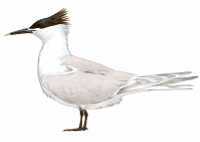
July 2020 Newsletter
Sandwich Terns.
June Bird News.
Forthcoming Events.
Latest Newsletter.
Sandwich Terns
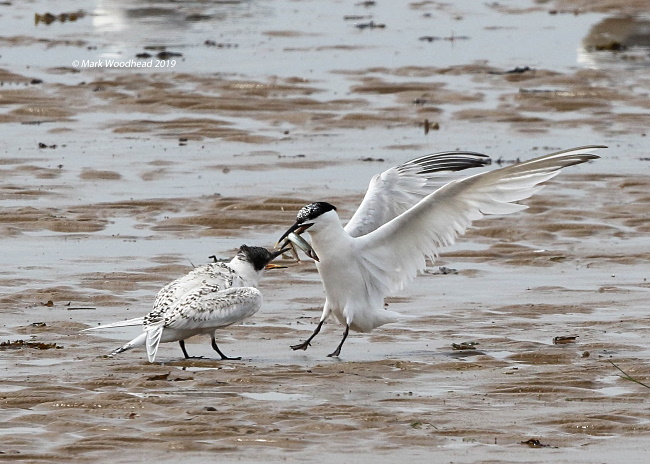
I always look forward to July because of the return of the Sandwich
Terns filling the Liverpool Bay coast with the sound of their strident kirrick calls.
Being close to a big flock of several hundred is an incredible
experience - constant noise and constant movement with hungry chicks
demanding food from the busy adults.
They are the first of our terns to start
breeding, laying eggs in early May, and the first to finish from late
June and into July. After breeding they
disperse widely and many congregate at staging posts around the UK with
the coastline from Gronant, across to Hilbre and north Wirral and up to
Ainsdale on the Sefton coast being one of the most
important areas in the country. Small numbers arrive here in
late June then quickly build up through July
with a peak in the first half of August. Many birds will have left to
go south by the end of August but numbers on passage in early September
can still be quite significant and these may be birds from colonies
further north or east. A few stragglers are usual in early October.
Total numbers in this Liverpool Bay area are likely
to peak at around 5,000 and, including juveniles, this will be 10 to
20% of the UK population. The main roost sites are at Gronant,
Point of Ayr, Hilbre, West Kirby, Hoylake, Formby Beach and Ainsdale.
Several hundred will also be distributed along the North Wales coast
with Rhos Point near Colwyn Bay a favourite spot.
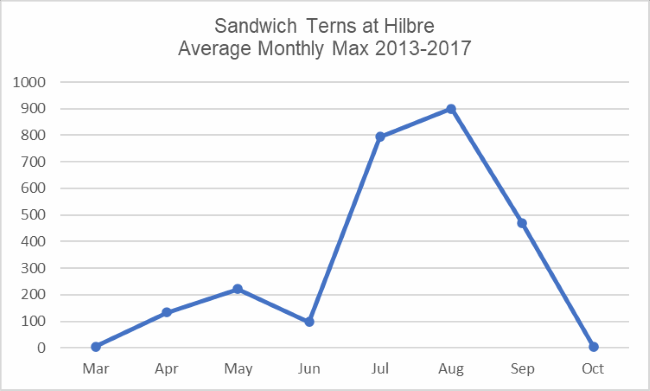
There is also a spring passage but with lower
numbers than in the
summer as birds don't linger at that time of year. The graph above of
birds counted at Hilbre shows the typical annual distribution. Peak
numbers usually occur in the first half of August but some years high
numbers are seen in both July and September.
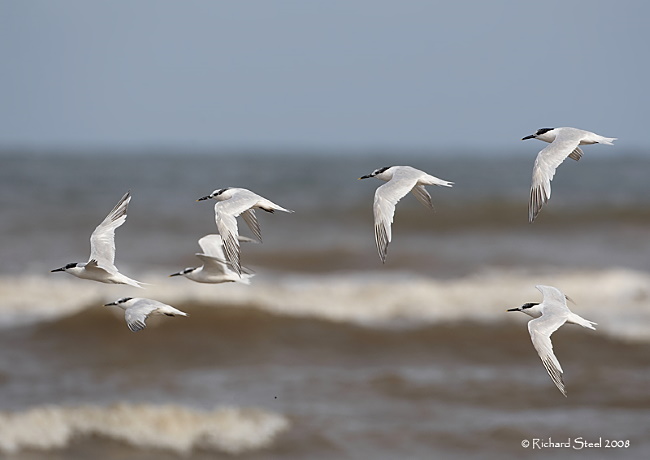
Sandwich Terns flying along north Wirral
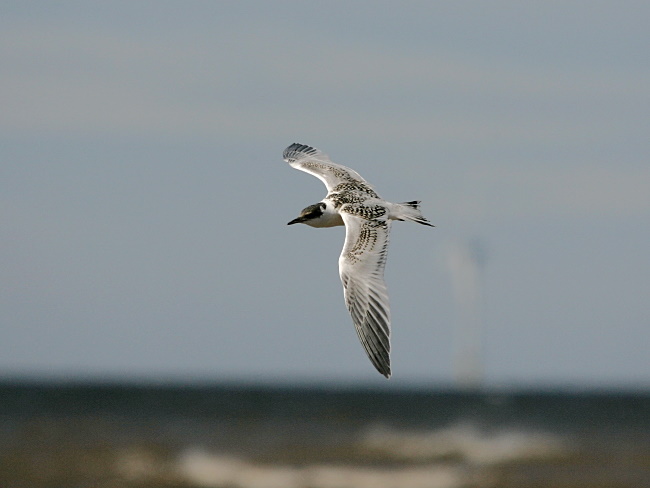
Juvenile Sandwich Tern at Hoylake ©
Steve Seal.
"Sandwich terns
exhibit the most erratic population trends and distribution of any
seabird breeding in the UK. The population fluctuates dramatically
among years due to large variations in the proportion of mature birds
attempting to breed and distribution varies owing to mass movements
between colonies." (Ref 1).
That quote is certainly true of our nearest breeding
colonies at Cemlyn Bay and Hodbarrow (see map below). At Cemlyn Bay
numbers have
fluctuated between 409 and 2,650 pairs over the past few years with
similar changes at Hodbarrow - but what is interesting is that when
birds have had problems at one colony, usually due to predation, then
they fly to the other one where they suddenly see a large increase in
pairs halfway through the breeding season. I quote the Cemlyn wardens
writing about the 2018 season (ref 2):
The
end of June/early July brought another surprise, as the Sandwich Tern
numbers almost doubled due to two further influxes. The Wardens were
able to establish that these birds had likely come from RSPB Hodbarrow
(Cumbria) where they had failed in their breeding attempt this season.
This was particularly interesting, as Hodbarrow appears to serve as an
alternate breeding site for these Sandwich Terns, and in recent years,
has possibly even become the preferred site. For those who may not
know, in 2017 the Sandwich Terns that abandoned Cemlyn actually re-laid
at Hodbarrow and successfully fledged around 500 chicks!
Map showing the main Sandwich Tern
Colonies in the British Isles
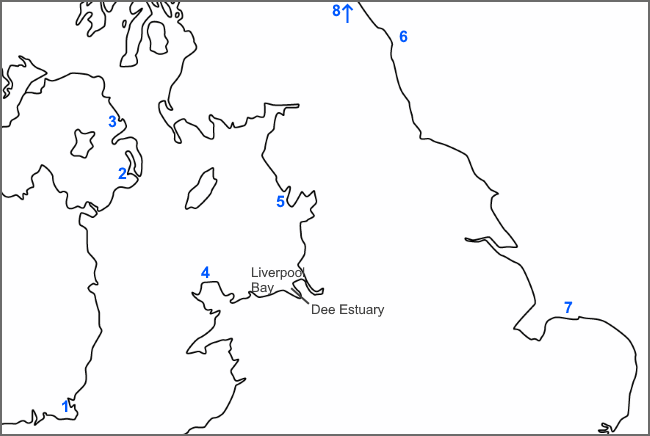
- Lady's Island, Wexford.
- Strangford Lough, Northern Ireland.
- Larne Lough, Northern Ireland.
- Cemlyn Bay, Anglesey.
- Hodbarrow, Cumbria.
- Farne Islands and Coquet Island, Northumberland.
- Blakeney Point and Scolt Head, north Norfolk coast.
- Sands of Forvie/Ythan Estuary, Aberdeenshire.
Although there are large variations in breeding numbers from year to year we can say that the largest colonies are at Wexford, Northumberland and Norfolk with the latter having the most pairs with up to 4,000 at Scolt Head. Birds from all the colonies shown on the map visit Liverpool Bay, as well as from the Netherlands. We know this because of colour ringing although this is a comparatively recent activity with, for example, Wexford starting in 2015, Hodbarrow in 2017 and Cemlyn Bay in 2019. I have managed to find details of 153 colour-ringed Sandwich Terns seen along the Liverpool Bay coast between Gronant and Ainsdale and they were ringed at the following sites (Ynsylas is a staging post in Cardigan Bay, Wales, all the rest are breeding colonies):
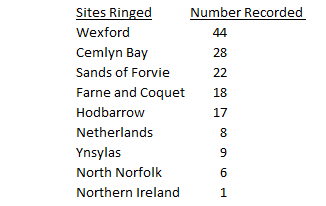
The
table reflects ringing effort as much as anything else. For example, we
get a surprising number from the Sands of Forvie in north-east Scotland
but they have been ringing there since 2008 compared to Cemlyn Bay
where the first ones were ringed only last year. Another complication
is that a bird may be ringed at one colony then move to another to
breed in following years. Nevertheless we do see birds which have been
seen/ringed at North Sea colonies in the breeding season which then
make their way to Liverpool Bay later that same summer. How do these
birds get to the Irish Sea? Sandwich
Terns, unlike Arctic Terns, are very rarely seen inland and the direct
evidence that they fly across the country is sparse - but I think
looking at the ringing records we have to assume that is what they do
rather than fly all around the coast including flying the 'wrong' way
up the Irish Sea. This includes birds breeding in south Netherlands
which must fly north-west to reach us.
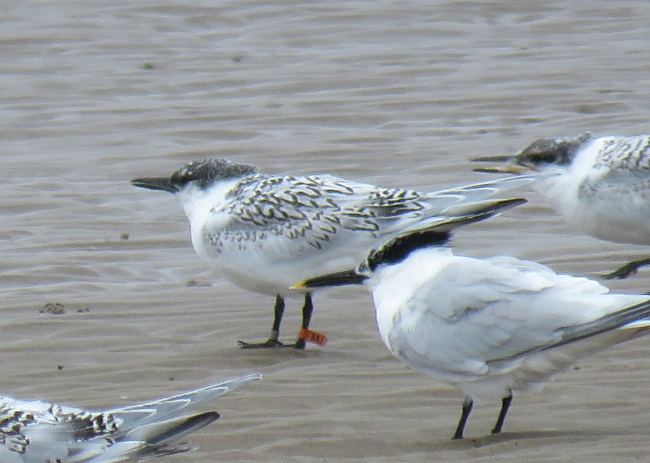
Juvenile with Orange flag AXJ, ringed
at Cemlyn Bay in June and photographed
near Hilbre in July.
© Richard Smith.
When they leave us at the end of August and
September they disperse widely and birds can spend the winter along the
coasts anywhere between France and South Africa. Unfortunately I don't
have a complete sightings list for the majority of the colour-ringed
birds recorded in Liverpool Bay but I do know that several have been
seen in Namibia and South Africa; however very few have been recorded
elsewhere on their wintering grounds. It is estimated that at any one
time slightly under 10% of the west-European Sandwich Tern population
are present in Namibia and South Africa. But it is thought that there
is a constant turnover of birds which means the total which make it
that far south is likely to be a lot higher than 10% of the population.
Of course many factors govern the reporting of colour-ringed birds
including observer effort, access to a decent telescope and the ability
to easily report any rings/flags. We know there is a site in Namibia
which is watched by keen colour ring spotters but elsewhere the
coverage is very variable. It will be interesting to see the reports of
the Orange flagged Cemlyn Bay birds which, I know from personal
experience, are definitely easier to read than most rings fitted to
Sandwich Terns.
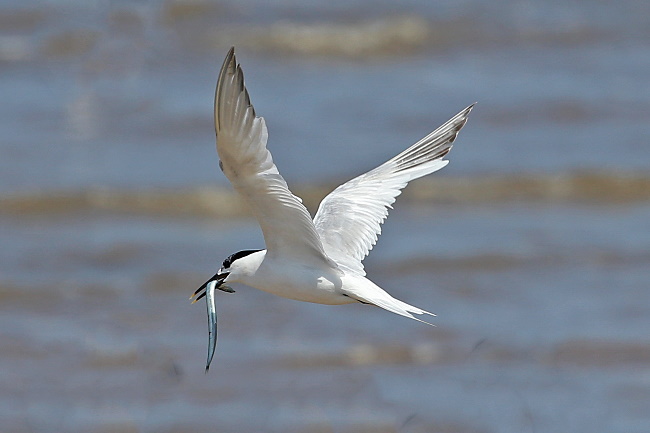
Food for the chick, Hoylake Shore © Roy Lowry.
History and Status of Sandwich Terns on the Dee Estuary/North
Wirral.
Rampant egg-collecting in the 19th century meant that the species almost became extinct as a breeding species in the British Isles and Coward writing in 1910 (and also in his 1916 supplement of Ref 3) doesn't even mention them as a bird seen in Cheshire. A bird at Marbury in 1918 is 'suggested' to be the first Cheshire record (Ref 4). I find that hard to believe, though, as birds were breeding in what is now Cumbria and on the Farne Islands in good numbers in early 20th century, and Eric Hardy writing in 1941 (Ref 5) talks about birds breeding at Ainsdale and Formby up to 1917 - surely some of these birds were seen off north Wirral before 1918? In the days before birdwatchers with telescopes perhaps they may have been seen but not identified, and it seems unless a bird was shot and then held in the hand it was not acceptable as a record!
By 1941 Eric Hardy was writing "In August big flocks of adult and young with other terns off Hoylake, Red Rocks and Wallasey", and interestingly "Ringing shows that Lancashire birds winter in West Africa and a few in Natal". Some remarkably early ringing returns. Hedley Bell writes "the numbers are often large with a maximum of over 70 seen off Hilbre on September 13, 1958", but then in 1965 the Hilbre Bird Report had this under the heading 'Mixed Terns' (Ref 6):
On
August 21st, 26th and September 5th literally thousands of mixed terns
were off the island, certainly in such numbers that had not previously
been recorded by the Observatory. The observers found it impossible to
specifically identify and count each species so the estimates of
numbers refer mainly to the Common, Arctic, Little and Sandwich Terns.
The estimates were as follows:- August 21st and 26th - c5,000 and at
least 1,000 respectively, Sandwich and "Comic" Terns predominated with
a few Little. September 5th - c10,000.
Heavy movement to the north-east during the two hours 05.30 - 7.30.
Majority Sandwich, then Little, with only a few "Comic".
One can only guess where these came from and
the weather conditions which caused such a concentrated passage, and
why were they flying north-east in September when birds should be
heading south? We
have never seen anything like this before or since. So I can put a
number on the bar chart below I've guessed that there were around 9,000
off Hilbre
on
Sep 5th 1965.
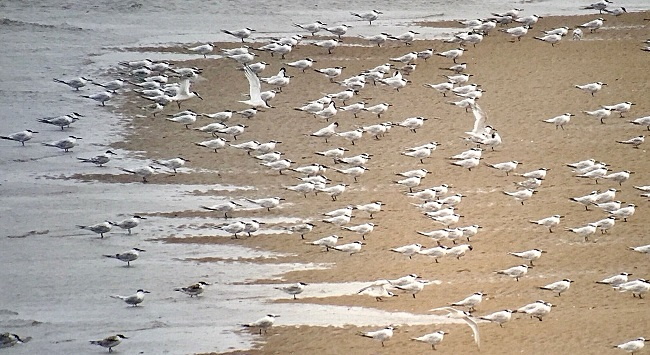
Part of the large flock present in August 2018 off Hilbre © Hilbre Bird Observatory.
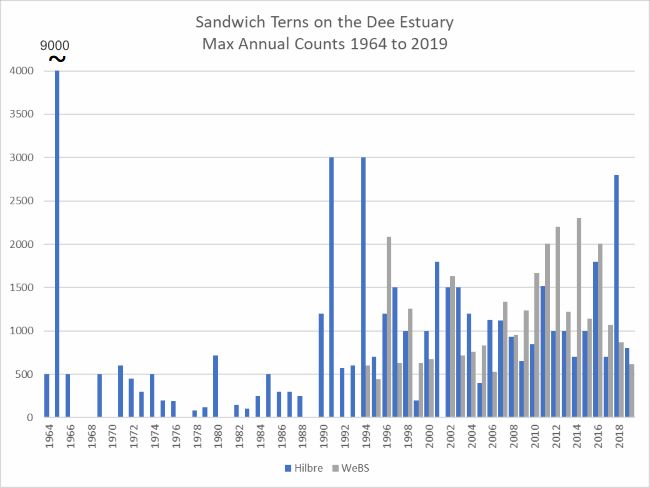
Counts of Sandwich Terns were only included in the WeBS (Wetland
Bird survey) from 1994. These counts are coordinated throughout
the estuary but taking place at high tide are likely to miss the many
birds which feed out at sea then, also they take place mid-month and
thus may miss the peak which is usually early August - so WeBS should
be regarded as a minimum count. Hilbre counts take place daily with
most birds counted roosting on the sand at low tide where it is likely
a good proportion of the Dee birds will be at low tide. Ignoring the
one off 1965 count there definitely seems to have been an increase in
birds from 1990 onwards. This doesn't correlate with national data
which shows lower numbers in the 1990s although they have recovered
since. But the local Irish Sea colonies seemed to be doing well at that
time including Lady's Island in Wexford
where pairs shot up from 400 in 1988 to 1500+ in 1991 and have
increased further since then. The Northern Ireland colonies increased
from around 1000 pairs in the early 1990s to over 3000 by 2005 and at
Cemlyn they were steady at around 500 pairs in the 1990s before
shooting up from 2001 reaching 2,650 by 2015 since when they have
decreased but did reasonably well in 2019 with 1,000 pairs.
I'm writing this in mid-June eagerly awaiting their return!
References:
1. Sandwich Tern, JNCC, 2020.
See: https://jncc.gov.uk/our-work/sandwich-tern-sterna-sandvicensis/
See: http://roseatetern.org/news/cemlyn-tales-2018-the-wardens-story
3. T.A. Coward, the Fauna of Cheshire, 1910 (and 1916 supplement).
4. Hedley Bell, The Birds of Cheshire, 1962.
5. Eric Hardy, The Birds of the Liverpool Area, 1941.
6. Hilbre Island Bird Report for 1965, Hilbre Bird Observatory.
7. Cheshire Bird Reports and Cheshire and Wirral Bird Reports 1964 to 2017, CAWOS.
8. Lancashire Bird Reports 2005 to 2018.
9. Stephen Dodd, pers. comm. re colour ringed Sandwich Terns at Cemlyn Bay and their resighting, 2019.
10. Peter Knight and Rose Maciewicz, pers. comm. June 2019. Peter and Rose have logged an impressive 118 colour-ringed Sandwich Terns along the Sefton coast since 2016.
10. David Cabot & Ian Nisbet, Terns, New Naturalist, Collins, 2013.
11. A.J. Tree, Origins, Occurrence and Movements of Sandwich Tern Thalasseus Sandvicensis in Southern Africa, Marine Ornithology 39: 173-181 (2011).
12. Hilbre Bird Observatory Blog, http://hilbrebirdobs.blogspot.com/.
13. WeBS Report Online, BTO, https://app.bto.org/webs-reporting/ .
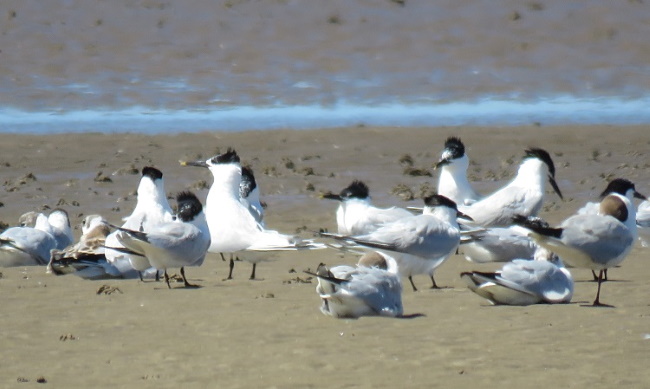
Typical scene on West Kirby
Shore in early July © Richard
Smith.
June Bird News
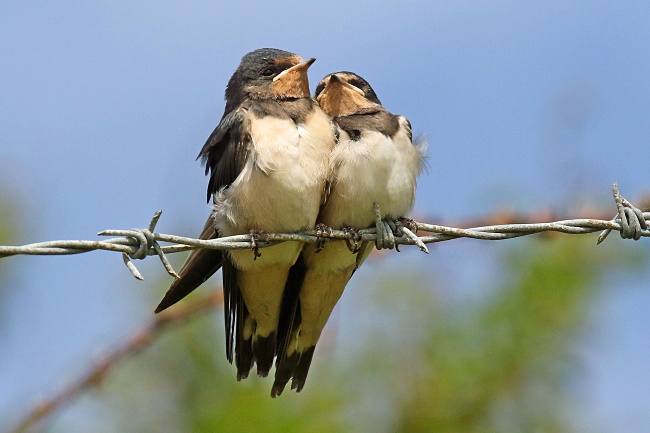
Early June saw some strong winds with over 50 Manx Shearwaters seen on
the 5th and at least six Storm Petrels the following day. Unfortunately
this same wind blew in a high tide which destroyed many Little Tern
nests at Gronant, but I'm told they have re-laid so hopefully they'll
still have a successful breeding season. Further strong winds at the
end of the month blew in an Arctic Skua at New Brighton.
RSPB Burton Mere Wetlands re-opened on the 15th and we were able to find out how the breeding season is going there. I'm sure Graham Jones (RSPB Dee Estuary Manager) won't mind me quoting him in full:
Weíve
had 3 pairs of Great White Egret nesting this year, not sure if theyíve
all been successful, but I did see the first 2 fledged birds on Monday.
The Spoonbills havenít shown any interest in breeding this year. Cattle
Egret havenít bred either, I last saw the pair in breeding plumage on 20th April.
Itís
been a good year for Bearded Tit with 3 pairs breeding. Not sure of the
number of young raised in total, although 2 pairs are still raising
second broods. 2 pairs of Marsh Harrier have nested this year, with a
pair feeding young at Burton Mere, and the regular pair feeding
young at Neston Reedbed. There was a third pair that attempted to breed
off the Old Baths but they seemed to have failed / lost interest.
Avocetís have had a below average year, with the drought causing most that were nesting on the wet grassland (which dried out completely) to fail. Weíve had good breeding success on the scrape though. Lapwing and Redshank have had a bad year at BMW, with the dry spring having a big impact. Although Redshank numbers have been good on the saltmarsh, especially at Parkgate.
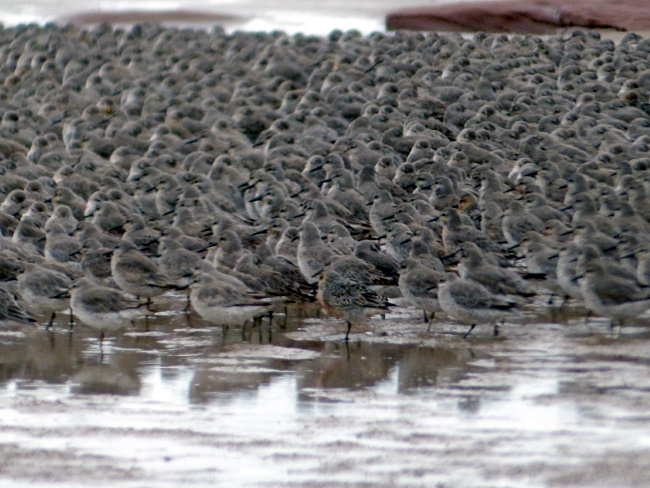
Thousands of Knot are normally unexpected in June, but because they had
had such a good breeding season in 2019 we were hoping to see the
immature birds over-summering here. At the end of May 28,000 were
counted between Southport and Seaforth, an amazing total, and quite a
few have made their way over here with 7,000 between Caldy and Heswall
mid-month and 10,000 roosting by Little Eye on the 28th. We think the
latter total is the highest June count since 1971.
Five red-head Goosanders were a first for
Thurstaston on the 10th and certainly unexpected in June, and there
continued to be two or three Quails around with birds at Burton and
West Kirby. Three spoonbills were regular at Parkgate.
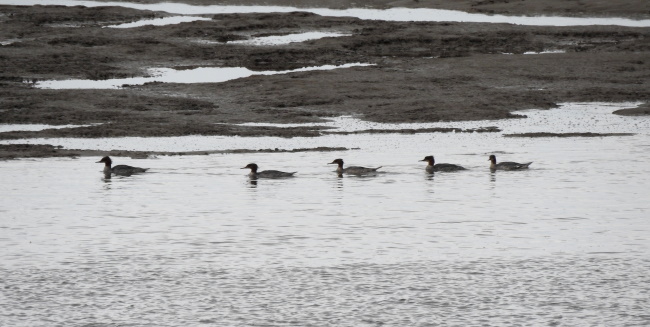
Crossbill and
Siskin Irruption
There was a major irruption of both Common
Crossbills and Siskins into England between June 23rd and 27th. Most
birds were recorded on the Yorkshire coast but some did reach us here
in the Dee Estuary area with a total of seven Crossbills plus numerous
Siskins, all on the 27th. Most of the Siskins seen here were flying
very high so no doubt most were missed and could have been in the
hundreds, and many of both species may well have been flying through
all the previous night. Although Crossbills and Siskins aren't totally
unknown here in June none have been reported over the previous five
years so this was certainly very unusual.
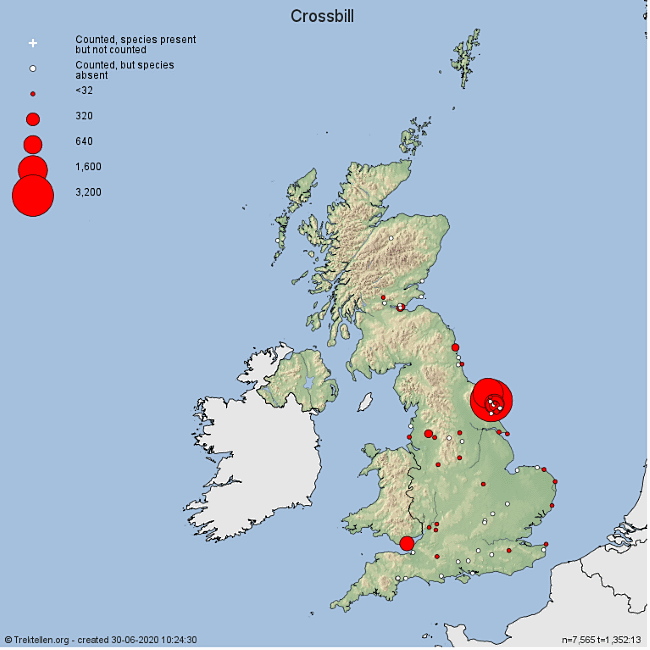
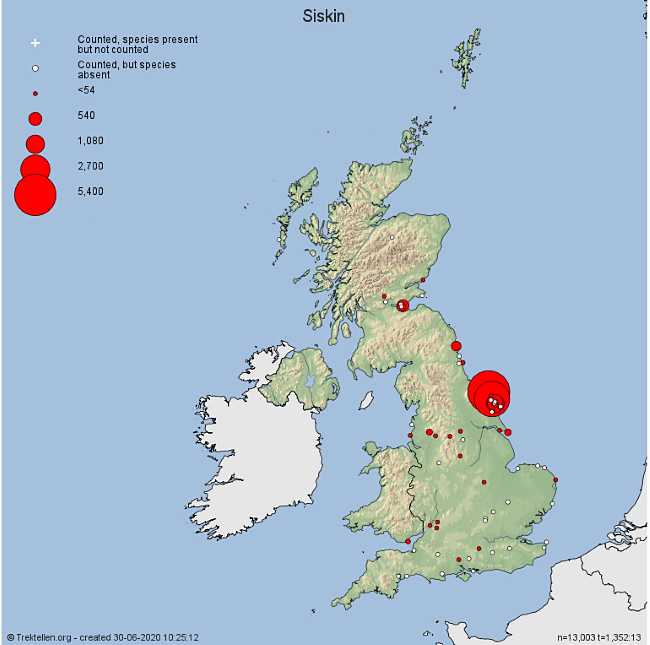
The numbers recorded along the Yorkshire coast was impressive with June totals of 7,707 Crossbills and 13,317 Siskins, as demonstrated on the above maps for June 20th to 30th. The biggest numbers were on the 25th and seen from Scarborough (1,223 Crossbills and 2,070 Siskins). The combined summer totals for 2016 to 2019, as recorded by the migration website (Trektellen.org), is just 292 Crossbills and 895 Siskins and this is for the whole country. Going back earlier, 2015 also saw an irruption of both Crossbills and Siskins but with much smaller numbers than 2020, the totals that year were 1,223 Crossbills and 2,070 Siskins through the three summer months. The 2015 irrruption took place in the last week in June and the first two weeks in July so we could well see the 2020 irruption continuing into July this year.
The 2020 irruption seems to have been confined to the UK as there were no reports from other north European countries of any significant movement. Given that they arrived in Yorkshire it seems likely that they crossed the North Sea from Scandinavia. It probably was caused by the good weather producing a big crop of young birds thus causing a shortage of food. The literature suggests that the earlier the irruption the more likely that the majority migrating will be young birds, the adults tending to move much later in the year.
For further reading try:
Ian Newton, Movement patterns of Common Crossbills in Europe, Ibis
(2006), 148 782-788.
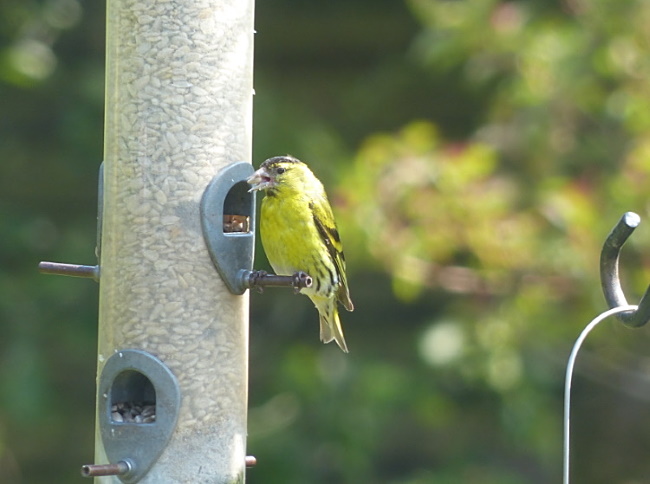
What to expect in July
As per the above article Sandwich Terns will be very much in
evidence
but there will also be plenty of Common Terns about feeding over the
sea from our two colonies at Seaforth and Shotton. I don't know if we
will be allowed to get to Gronant but there should be plenty of
fledglings on the beach by the end of July, and we always get an
influx of adults from other Irish Sea colonies round about the third
week with may be as many as 800 birds in total. Arctic Terns are also a
possibilty, look out on the edge of East Hoyle Bank for these.
As well as terns the estuary will fill up with gulls
and it's always good to see Mediterranean Gulls in full breeding
plumage. Also in summer plumage will be returning waders and there
should be plenty of Dunlin and Black-tailed Godwits, with a good chance
of seeing one or two Knot, Bar-tailed Godwit and Spotted Redshank.
Whimbrels will also be coming through on their way south as will
Common, Green and Wood Sandpipers although only in small numbers.
Given a strong westerly sea-watching can be
excellent with skuas, Manx Shearwaters and Gannets.